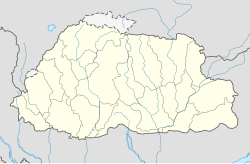Thimphu
ཐིམ་ཕུག | |
|---|---|
Capital city and Thromde | |
From top, left to right: Tashichho Dzong, National Library of Bhutan, an aerial view of Thimphu, Thimphu Business District | |
Location of Thimphu in Bhutan | |
| Coordinates: 27°28′20″N 89°38′10″E / 27.47222°N 89.63611°E | |
| Country | |
| District | Thimphu |
| Gewog | Chang |
| Established as capital | 1955 |
| Township | 1961 |
| Municipality | 2009 |
| Government | |
| • Druk Gyalpo | Jigme Khesar Namgyel Wangchuck |
| • Thrompon | Ugyen Dorji[1] |
| Area | |
• Total | 26.1 km2 (10.1 sq mi) |
| Elevation | 2,320 m (7,656 ft) |
| Population (2017) | |
• Total | 114,551 |
| • Density | 4,389/km2 (11,370/sq mi) |
| Time zone | UTC+06:00 (BTT) |
| Area code | +975-2 |
| Climate | Cwb |
| Website | thimphucity.bt |
Thimphu (/tɪmˈpuː/; Dzongkha: ཐིམ་ཕུག [tʰim˥.pʰu˥]) is the capital and largest city of Bhutan. It is situated in the western central part of Bhutan, and the surrounding valley is one of Bhutan's dzongkhags, the Thimphu District. The ancient capital city of Punakha was replaced by Thimphu as capital in 1955, and in 1961 Thimphu was declared as the capital of the Kingdom of Bhutan by the 3rd Druk Gyalpo Jigme Dorji Wangchuck.
The city extends in a north–south direction on the west bank of the valley formed by the Wang Chhu, which flows out into India as the Raidāk River. Thimphu is the sixth highest capital in the world by altitude and ranges in altitude from 2,248 metres (7,375 feet) to 2,648 metres (8,688 feet).[2][3][4][5][6] Unusually for a capital city, Thimphu does not have its own airport, instead relying on the Paro Airport (connected by road some 52 kilometres (32 miles) away).
Thimphu, as the political and economic center of Bhutan, has a dominant agriculture and livestock base, which contributes to 45% of the country's GNP.[7] Tourism, though a contributor to the economy, is strictly regulated, maintaining a balance between the traditional, development and modernization. Thimphu contains most of the important political buildings in Bhutan, including the National Assembly of the newly-formed parliamentary democracy and Dechencholing Palace, the official residence of the King, located to the north of the city. Thimphu is coordinated by the "Thimphu Structure Plan, 2002-2027", an urban development plan with the objective of protecting the fragile ecology of the valley. Some of this development was undertaken with financial assistance from the World Bank and Asian Development Bank.
The culture of Bhutan is fully reflected in Thimphu in literature, religion, customs, and national dress code, the monastic practices of the monasteries, music, and dance, and in the media. Tshechu is an important festival when mask dances, popularly known as Cham dances, are performed in the courtyards of the Tashichho Dzong in Thimphu. It is a four-day festival held every year in September or October, on dates corresponding to the Bhutanese calendar.
- ^ Dema, Chhimi. "Thimphu votes for change". Kuensel.
- ^ "Thimphu Dzongkhag". Government of Bhutan. Archived from the original on 2010-09-08. Retrieved 2010-06-08.
- ^ "Bhutan". Tourism Council of Bhutan:Government of Bhutan. Archived from the original on 2018-04-09. Retrieved 2010-06-07.
- ^ "Introduction: Understanding Natural Systems". Government of Bhutan. Archived from the original on 2012-12-03. Retrieved 2010-06-07.
- ^ Brown, p. 97
- ^ Palin, p. 245
- ^ "Economy". Tourism Government of Bhutan. Archived from the original on 2014-06-14.






